
How Stephen Gould Scaled Its Capacity by 30% without Making a Single Hire
The all-in-one collaboration software is designed to help teams be more productive and work more efficiently by enabling them to share, manage documents, files, and other types of data, and work together on projects and tasks from any location and any device.
Executive Summary:
The all-in-one collaboration software is designed to help teams be more productive and work more efficiently by enabling them to share, manage documents, files, and other types of data, and work together on projects and tasks from any location and any device.
In today’s digital age, collaboration is an essential component of every business.
With remote work becoming more common, businesses need efficient ways to communicate and collaborate, share files, manage tasks, and track projects in one place.
That’s where all-in-one collaboration software comes in.
An all-in-one collaboration software integrates multiple communication and collaboration features in one platform, making it easier for teams to work together.
In this blog post, we’ll explore what is all-in-one collaboration software, how it can benefit your business, and why you should consider using one.
The history of traditional collaboration software started more than 30 years ago when companies began forming their IT departments and needed to piece together products from various vendors to get the full range of functionalities needed to perform their job. At that time, collaboration software was a single solution for the team’s single use case whether that has been task management, data, or chatting.
Fast forward to the technologically advanced present, these types of collaboration software called point solutions still exist but have been long outperformed by all-in-one collaboration solutions.
The all-in-one collaboration software is designed to help teams be more productive and work more efficiently by enabling them to share, manage documents, files, and other types of data, and work together on projects and tasks from any location and any device.
There are many benefits that come with collaboration software. Perhaps the most important of all is the opportunity to improve productivity amongst teams who don’t necessarily work in the same office, same country, or the same time zone.
Here are some other benefits of all-in-one collaboration software and how they lead to productive teamwork:
Communication, they say, is the key to teamwork.
Communication and collaboration in person are great, but when that’s not possible online tools like all-in-one collaboration software help us keep up the flow of conversations, feedback, and ideas. Efficient communication not only boosts productivity but also helps prevent and resolve problems faster.
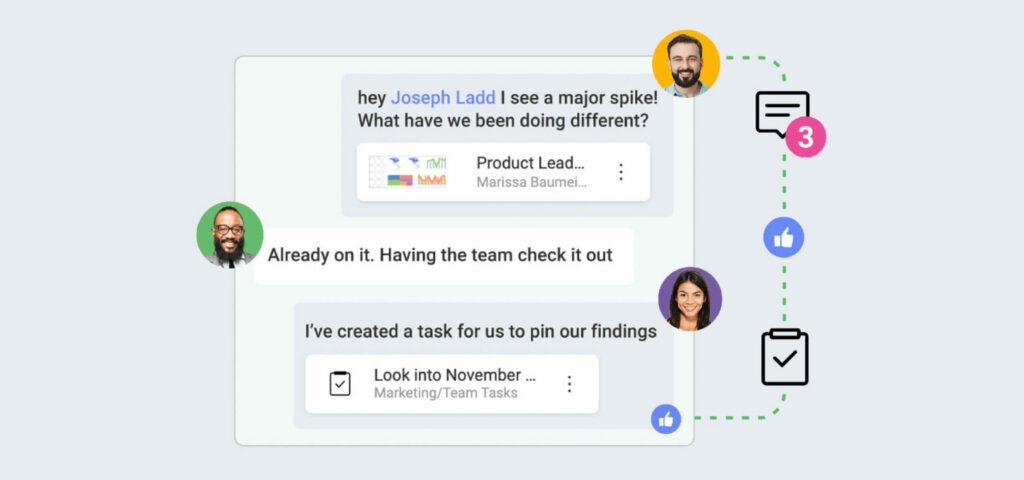
Managing one project can be a simple task, but what about managing tens of projects at the same time? How can you avoid getting lost in the organization and coordination of events or projects without the help of a collaboration tool?
Luckily, you don’t have to worry about that. All-in-one collaboration software ensures everything is on track in order to avoid mistakes and confusion that can delay projects or individual tasks.
When using various tools for managing tasks, communicating, and storing files, it is easy to lose track of what has been done, what hasn’t, who said what, and which task they were referring to. Everything is a mess. But keeping all aspects of your projects and tasks organized doesn’t have to be complicated. All-in-one collaboration software assists in creating calm and organization in your team’s workflow through open communication and coordination of projects and events by keeping everything on one platform where nothing gets mysteriously lost.
With the power of a data analytics solution, your team will no longer need to waste time trying to analyze spreadsheets to source their data but instead have more time to focus on the insights gathered and make choices based on facts that will help you reach your company goals and objectives faster. Having that available in one place with all other productivity tools brings instant effortlessness and effectiveness to the data-driven decision-making process.
Every collaboration software is different, yet most tools will (or should) include the following features:
Project management – Organize all aspects of a project from planning and scheduling to resource allocation and execution.
Task management – Everything that’s needed to manage a task through its life cycle from planning to execution. Set deadlines, dependencies, and priorities, and ensure the project stays on track and gets completed on time.
Document management – The document management feature is important for every all-in-one collaboration software. It allows users to share and work on documents together by easily integrating third-party cloud storage apps into the platform. This feature also helps in keeping documents neatly organized in one place, so everyone can easily access them at any time.
Cross-functional collaboration – A single place where everyone within your organization (marketing, sales, HR, logistics, developers, support, etc.) comes together to work on a goal or project.
Internal messaging – This is a must-have feature that can help to keep communication organized and on-topic. The ability to communicate in-app and collaborate on individual tasks and projects sharing comments, feedback, and ideas, all while keeping a historic record of discussions that everyone can refer to at any time. Most all-in-one collaboration tools also provide users with the ability to comment on task and project levels and to attach files to further support tasks and projects.
Data analytics – That feature is not very common, but highly beneficial for the health of your business. By having access to real-time data, users can make better-informed decisions that are not gut-based but backed up with key data insights. Nowadays, data analytics is a must for every company. Startups shouldn’t neglect it as well – data can help startup companies grow much faster.
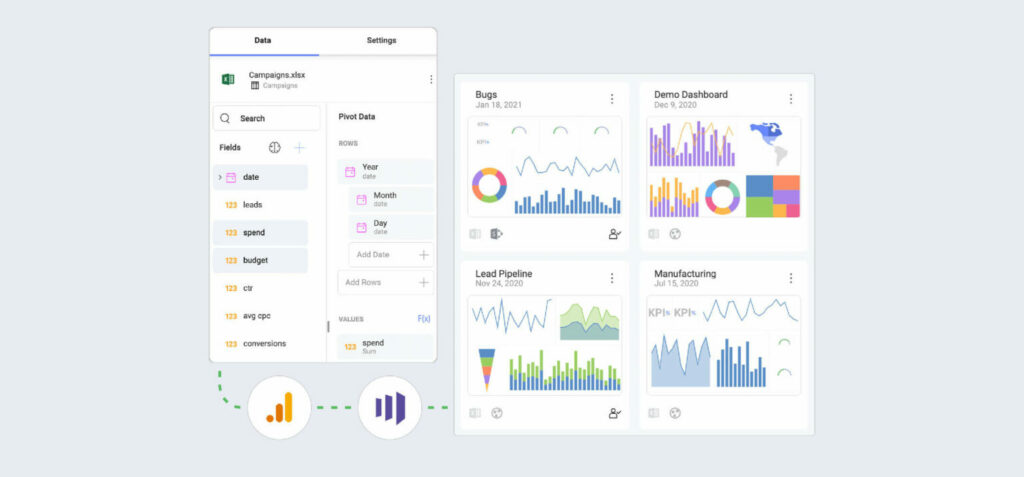
Notifications – To stay up to date with all recent modifications made to tasks, mentions, discussions, and more.
Integration opportunities – With all-in-one collaboration software, users should be able to access all types of documents, files, and resources, some of which are stored in a third-party application. Thus, it is important for your chosen all-in-one collaboration software solution to offer robust integration opportunities with tools such as Dropbox, Google Drive, etc.
Intuitive interface – Good all-in-one collaboration software should be intuitive and user-friendly and shouldn’t take more than a few days to get used to. The purpose of these kinds of tools is to simplify the work process and make it more efficient, so one of the most important features of any collaboration software is to be simple and straightforward.
Mobile-friendly design – All-in-one collaboration tools should be able to function properly on mobile phones and tablets, too. Remote employees or employees whose duties require moving around are not always going to be in front of the desktop, so providing them with a solution that allows them to stay productive and work on their tasks even on the go should be a top priority.
Security – When focusing on the features that all-in-one collaboration software solutions provide, you should not forget about the importance of data protection and security. And while some free collaboration software tools offer less protection than enterprise tools, they all should require logins and passwords to protect the data and information shared on the platform. If the collaboration software offers two-factor authentication, the better. It helps prevent security breaches and verifies the user’s identity.
Collaboration tools are great as they increase the team’s efficiency and productivity, and you want that for your business, but then you face the dilemma of what type of solution you should actually choose: all-in-one or point solution?
To help you understand some key differences better and each solution’s pros and cons, we made that comparison table for reference:
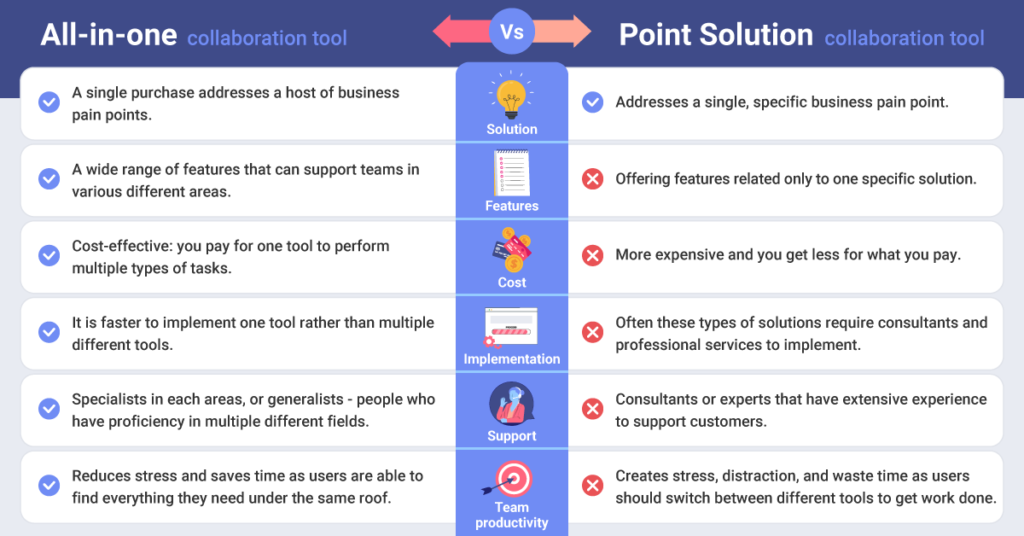
Getting all-in-one collaboration software for your team is a critical business decision. You wouldn’t want to waste time and money testing every solution available on the market. We help you narrow down your choices, so you can make the best decision possible – both for your team and business.
Here are the 6 main factors to keep in mind when choosing an all-in-one collaboration solution:
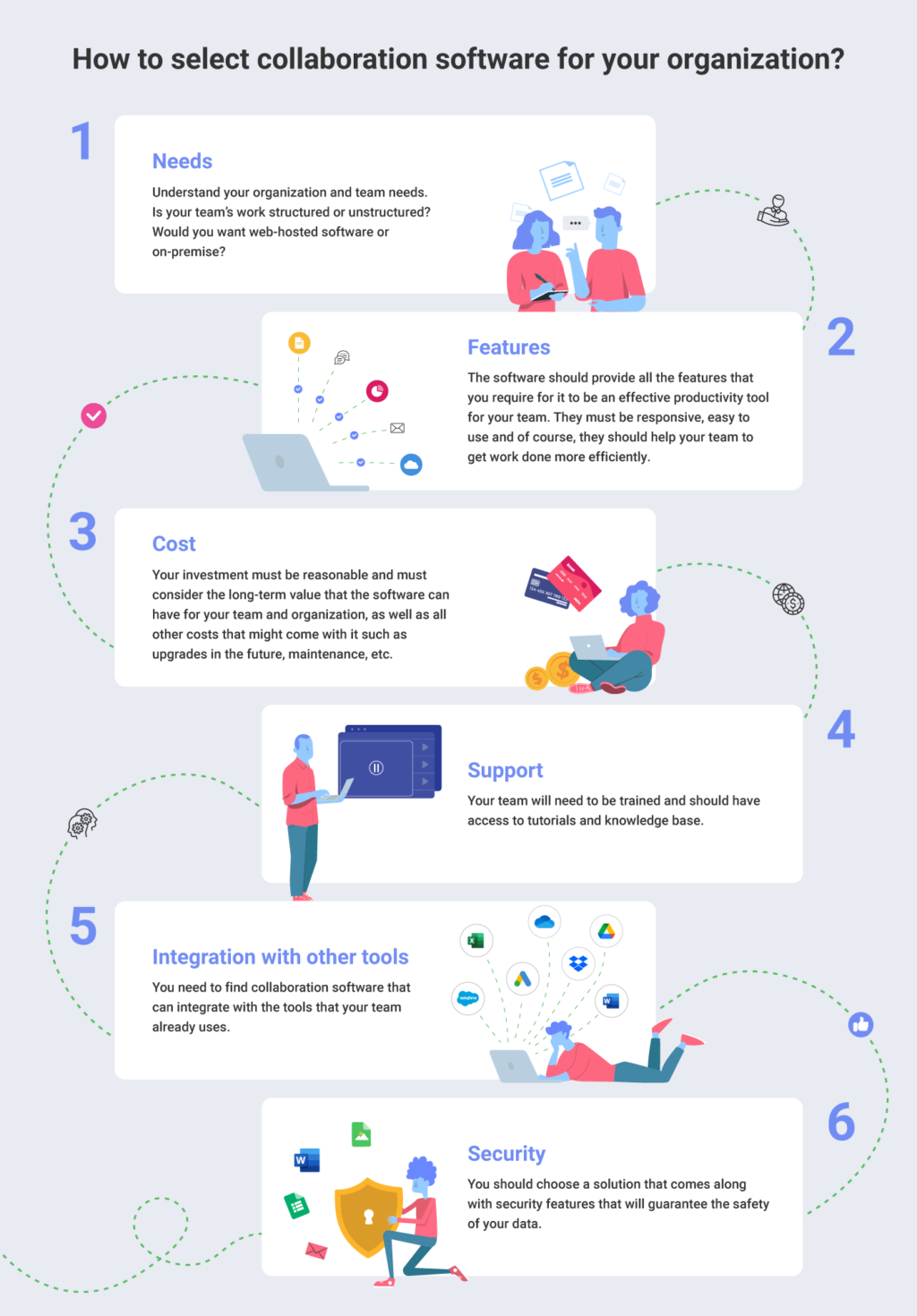
1. Needs – The first step of choosing an all-in-one collaboration software is understanding your organization’s needs – how does your team currently work, what could and should be improved in their work process, and is their work structured or unstructured? To find the answers to these questions, you should not only observe your teamwork from a distance, but you should consult with them. Those are the people that will use this collaboration software after all, so their needs and their opinion on the matter are what you should care most about in the first place.
What else you should consider in this first step is whether the solution is web-hosted or on-premises. Will your organization’s data and files be secure? After you have determined your specific needs, then you can move on to the next step.
2. Features – The features that the all-in-one collaboration software offers are the missing puzzle pieces for your organization. The software should provide all the features that you require for it to be an effective productivity tool for your team. They must be responsive, easy to use, and of course, they should help your team to get work done more efficiently.
3. Cost – How much does your budget allow for this kind of software? Your investment must be reasonable and must consider the long-term value that the software can have for your team and organization, as well as all other costs that might come with it such as upgrades in the future, maintenance, etc.
4. Support – Reliable support is a must. Your team will need to be trained and should have access to tutorials and a knowledge base. If the vendor doesn’t offer this, then you better move on to the next one.
5. Integration with other tools – You need to find collaboration software that can integrate with the tools that your team already uses. Don’t ignore this factor if you chose a tool that cannot integrate with other tools needed by your team, then the software won’t be that much of a help – your team will still need to switch between apps to be able to access everything needed to complete its job.
6. Security – Security is important, so in any case, you should choose a solution that comes along with security features that will guarantee the safety of your data. You should also be able to choose where your data will be stored. If a vendor doesn’t offer security features or only offers weak security, wave goodbye to it and continue searching for a better solution.
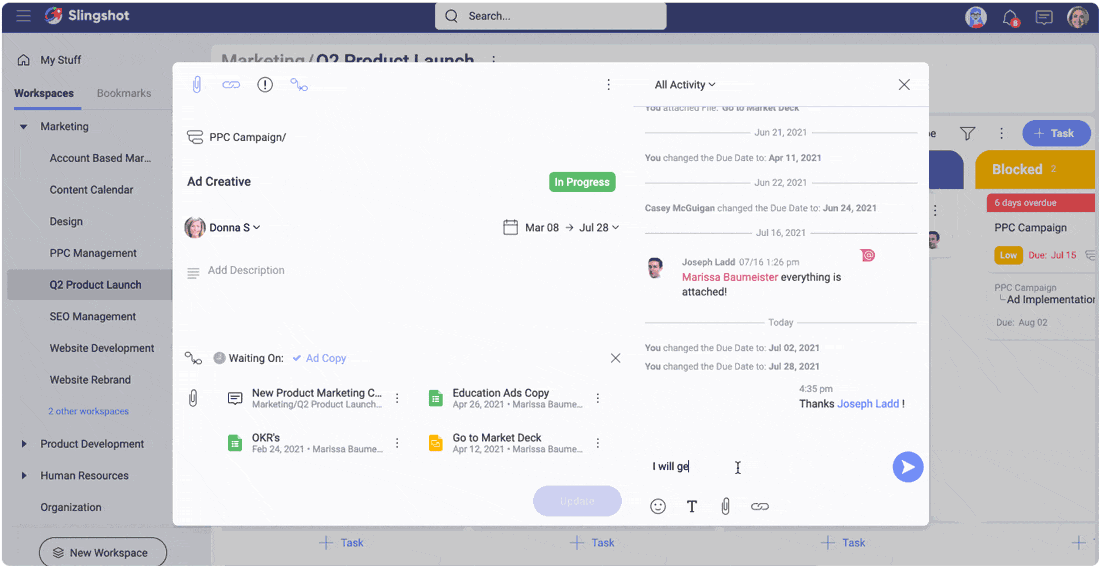
Slingshot simplifies collaboration by incorporating modern project and team file management, chat, and data analytics all within one app. When you can easily share all these elements in one place with team members and share projects with external team members, calmness is restored. With robust productivity flows out of the box and is designed to work seamlessly to enable continuous collaboration workflows. This helps teams cut across collaboration silos, prevents work disruptions, and makes it easier for teams to work better together.
SHARE THIS POST